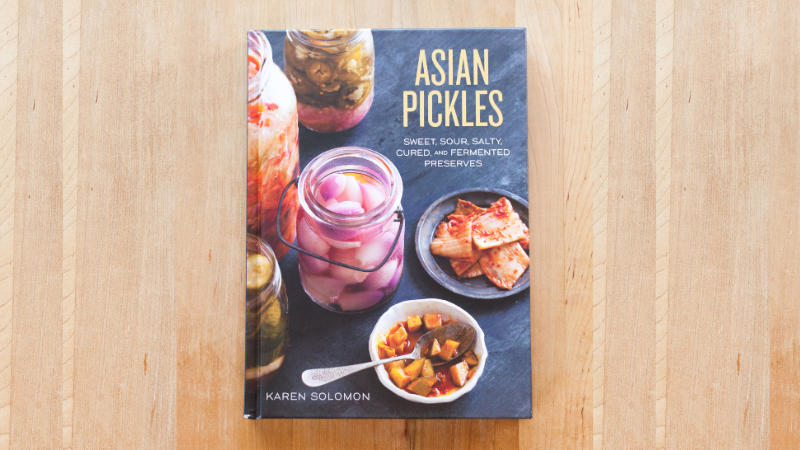Asian cuisine is a rich tapestry of flavors, colors, and traditions that have been captivating the taste buds of food enthusiasts around the world. In the heart of this culinary journey lies a hidden gem – the art of pickling. From the tangy, crunchy kimchi of Korea to the delicate, aromatic pickles of Japan, the diverse range of Asian pickles reflects centuries of culinary evolution.
Today, we delve into the pages of “Asian Pickles,” a captivating book that takes us on a delightful exploration of this time-honored tradition. Join us as we immerse ourselves in the world of brine, spices, and fermentation, uncovering the secrets and stories behind these beloved condiments.
Table of Contents
ToggleAsian Pickles–A Book Review
“Asian Pickles” by Karen Solomon is a culinary masterpiece that explores the art of pickling from various Asian cuisines. From Korea to India, Japan to the Philippines, this book offers a delightful journey through the diverse world of pickles. As a blog writer with a keen interest in food and culture, I couldn’t help but be captivated by the depth and diversity of flavors that this book brings to life.
Also Read:- Best Fermented Foods
One of the standout features of “Asian Pickles” is its comprehensive approach to pickling. The author, Karen Solomon, leaves no stone unturned when it comes to introducing the reader to different pickling techniques, ingredients, and regional variations. The book is thoughtfully organized, making it easy for both beginners and experienced picklers to follow along.

Solomon begins by explaining the basic principles of pickling, ensuring that even those new to the art can grasp the fundamentals. She covers essential equipment, ingredients, and techniques, providing clear and concise instructions. This is invaluable for someone like me, who enjoys experimenting with new recipes but also appreciates a solid foundation.
The heart of the book lies in its exploration of pickling traditions from various Asian countries. Solomon’s writing is not only informative but also engaging and personal. She shares anecdotes, stories, and experiences related to her travels and interactions with people from these diverse cultures. This adds a delightful human touch to the book, making it not just a cookbook but a culinary travelogue.
Each chapter is dedicated to a specific country, and within these chapters, readers are introduced to a variety of pickles unique to that region. From the fiery kimchi of Korea to the fragrant achar of India, the book is a treasure trove of recipes. Solomon’s meticulous attention to detail ensures that the recipes are easy to follow, with clear instructions and vibrant, mouthwatering photographs that make your culinary journey even more enjoyable.
Don't just scroll, subscribe!
BuzzTrail's unique web-stories are the cure for boredom you've been waiting for.
As a writer, I greatly appreciate the cultural context provided in “Asian Pickles.” It’s not just about recipes; it’s about understanding the history and significance of pickles in these various cuisines. The book delves into the roots of pickling, discussing how it has been used as a method of preservation, a way to enhance flavor, and even for medicinal purposes. These insights are a goldmine for anyone looking to enrich their writing about food and culture.
One of the standout aspects of this book is the accessibility of the recipes. While some cookbooks can be intimidating with exotic and hard-to-find ingredients, “Asian Pickles” ensures that the reader can recreate these delightful pickles in their own kitchen. Solomon provides alternatives for ingredients that might be challenging to find, making it inclusive for a wide range of readers. This aligns with my blog’s philosophy, as I always aim to create content that can be enjoyed and appreciated by a broad audience.
The flavor profiles in “Asian Pickles” are simply outstanding. The combination of sweet, salty, sour, and spicy flavors in these pickles is a sensory delight. Whether you’re looking for a zesty side dish to complement a main course or a snack that excites your taste buds, you’ll find something to savor in this book. The fusion of ingredients and spices is a testament to the richness of Asian cuisine.
Another aspect that I found particularly appealing is the book’s commitment to sustainability. In a world where we are increasingly conscious of our impact on the environment, pickling is a time-honored method of food preservation that reduces food waste. “Asian Pickles” encourages readers to embrace this sustainable approach and make the most of seasonal produce.
Also Read:- Spicy Pickled Green Beans
The only minor drawback of the book is that some recipes may require a bit of preparation and patience. Pickling is not a quick process, and some recipes need to sit for several days to develop their full flavor. However, this is a small trade-off for the exceptional taste and quality you’ll achieve.
Conclusion:
In conclusion, “Asian Pickles” by Karen Solomon is a must-have for anyone interested in exploring the world of pickling, Asian cuisine, or simply adding a burst of flavor to their meals. It’s a book that marries tradition with modernity, and its cultural insights, approachable recipes, and captivating storytelling make it an invaluable resource for writers, home cooks, and food enthusiasts alike. Whether you’re a novice in the kitchen or a seasoned chef, this book is a gem that deserves a prominent place in your cookbook collection. As a blog writer, I am excited to share the wonders of “Asian Pickles” with my readers, knowing that it will be a culinary journey they won’t soon forget.
FAQs
Who are the authors of “Asian Pickles”?
Who are the authors of “Asian Pickles”?
The book “Asian Pickles” is authored by Karen Solomon, a culinary expert with a passion for preserving, and Nathan Hodge, an experienced food and travel writer.
What types of pickles are featured in the book?
What types of pickles are featured in the book?
The book covers a wide range of pickles, including classic favorites like kimchi, as well as lesser-known varieties from different Asian countries. You’ll find pickles made from vegetables, fruits, and more.

